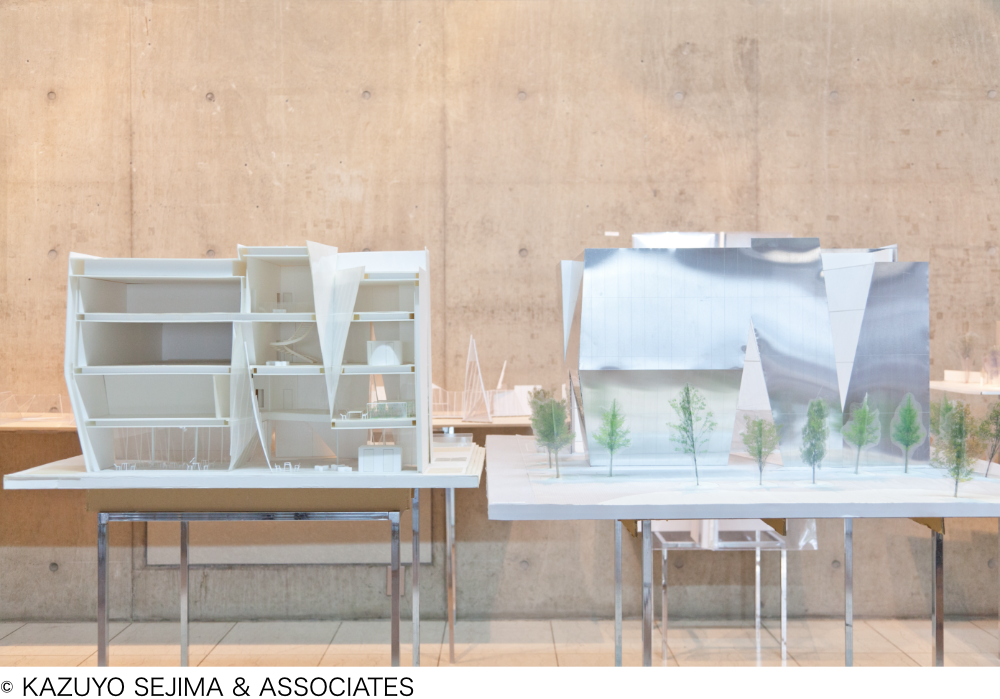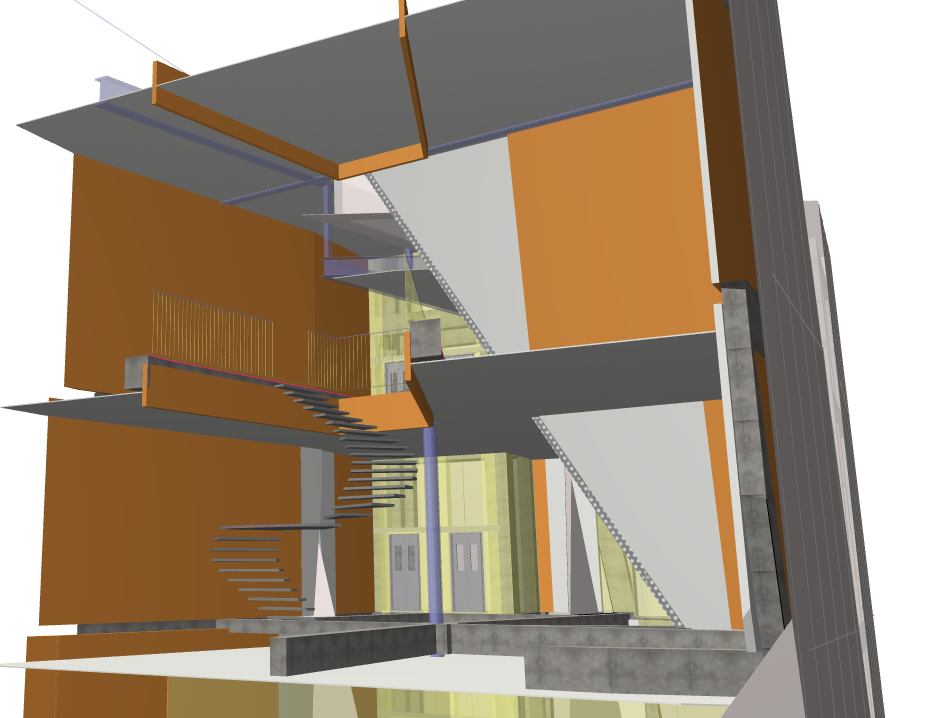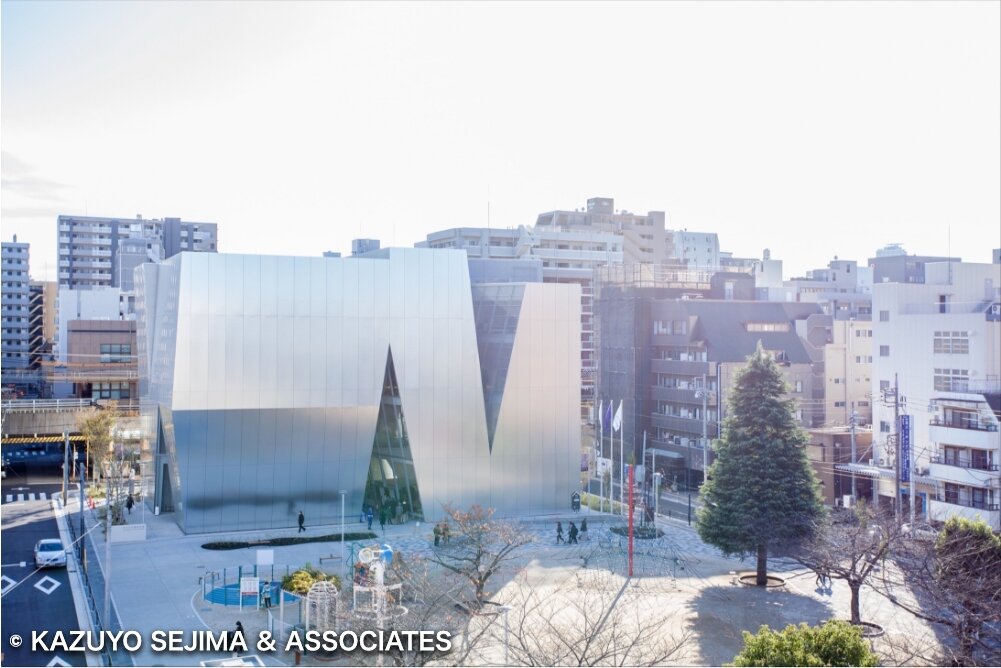Expanding Business Fields (1) Building Construction Business
Innovation of the Production System
A serious issue facing the construction industry is the aging of skilled workers who are the lifeblood of construction sites. According to an estimate given in 2015 (Toward Revitalization and Evolution, Japan Federation of Construction Contractors), of the 3.4 million skilled workers who work at construction sites, one-third, or 1.1 million, are predicted to retire in the decade leading up to 2025. Consequently, aside from developing and retaining human resources, the pressing issues weighing heavily on the construction industry as a whole also included developing construction methods that would enable labor saving and shortened delivery times, as well as the innovation of the production system.
Obayashi Corporation was one of the first in the industry to introduce Building Information Modeling (BIM), which uses 3D models to allow a user to “visualize” the construction process all the way from design to construction and maintenance management, as well as various information relating to a building. The company worked hard to reduce the time spent on tasks, which consequently allowed for labor reduction and shorter delivery times. This was achieved by updating floors to prestressed concrete at actual construction sites, as well as implementing a method for large-scale system formwork and a method for assembling rebar covering a two-span beam–column assembly on the ground.
With regard to precast construction, which involves assembling factory-produced columns, beams, and joint components at the construction site, the Left–Right–Vertical (LRV) construction method was developed in 2008 by adding unique improvements that made the method suitable for high-rise reinforced concrete residential buildings. Further improvements were made in 2016. The civil engineering and building construction teams worked together to apply the LRV method in the construction of railway viaducts, which led to further significant reductions in project delivery times.
The company also introduced the horizontal multi-section structural work method, which reduced and standardized workloads in each construction section. By increasing the number of construction sections and splitting rebar work, formwork, scaffolding, and earthwork into an amount that could be completed in about one day, each worker was able to execute the same tasks each day. This method has resulted in reduced down time when changing between different types of construction and less fluctuation in the number of workers required, making it easier to secure the necessary workforce on site. Also, for the workers, completing the same tasks every day has led to improvements in proficiency. In addition, the number of times that formwork is re-appropriated is increased, and the number of molds used is reduced. The company’s 3R (Reduce, Reuse, and Recycle) project using the horizontal multi-section structural work method took an award at the FY2015 3Rs (Reduce, Reuse, and Recycle) Promotion Merit Awards.
Aiming to Realize a Sustainable Society
The Sustainable Development Goals (SDGs) were adopted at a United Nations summit held in September 2015. Then, at the 2015 United Nations Climate Change Conference (COP21) held in December of the same year, the Paris Agreement was adopted as a multilateral international agreement to curb climate change. Japan also ratified this agreement and set forth goals to reduce greenhouse gas emissions by 26 percent by 2030 (compared to 2013).
Against this backdrop, Obayashi Corporation, which upholds its Obayashi Green Vision 2050, has set an aim of realizing a society that is low-carbon, recycling-oriented, and respects the natural world through initiatives centered on the construction business. The company has set a goal of reducing the energy consumed in its main business area of domestic construction works by 18 percent by 2020 (compared to 2010). Initiatives to achieve the goal involve proposals and designs for energy-saving buildings—a prime example of this is ZEB—as well as the development and proliferation of technologies and materials that can realize decarbonization. In addition, the company also planned to reduce the amount of energy consumed at construction sites by developing and implementing energy-saving heavy equipment, switching to LED bulbs in temporary lighting, and promoting increased awareness of energy reduction among each and every person involved with the job.
Meanwhile, the company has also been working on developing new energies, putting its efforts into technical development and demonstration testing that looks toward the full-scale use of energy systems using power generation facilities fueled by hydrogen. The Ministry of Economy, Trade and Industry has drawn up the Strategic Roadmap for Hydrogen and Fuel Cells, which calls for the use of the ultimate clean energy source that does not emit carbon dioxide, that is, hydrogen. As a first step, the ministry has announced the installation of 100 hydrogen stations across Japan for fuel-cell vehicles (FCV). The company has worked together with Iwatani Corporation on projects that make use of hydrogen, and continued to push forward with the construction of hydrogen stations in various regions.
In April 2015, the Iwatani Hydrogen Refueling Station in Shibakoen, Minato City, Tokyo, which was designed and constructed by Obayashi Corporation, was completed. This was the first hydrogen station in Japan to also have a car showroom annex building, which showcased a range of FCVs manufactured by Toyota Motor Corporation. Presenting the features of FCVs and hydrogen through videos, the station also functions as a platform for communicating information toward the realization of a hydrogen society.
Focusing Efforts on Renovation Works
The renovation market showed a great deal of promise and was predicted to continue growing, possibly becoming one of the pillars of the building construction business. The expansion of the renovation works business was therefore positioned as one of the main areas of priority for the company. Securing more contracts and improving profits in the renovation sector required accurately grasping the potential customer demand for renovation, and creating proposals that leveraged the company’s comprehensive capabilities in design, technology, and development based on BCP (business continuity plan) support and new technologies for energy saving and energy creation, which would then lead to receiving new orders.
To this end, the Renovation Design Department was newly established in October 2014 as part of the Architectural Design & Engineering Division. Through the establishment of the new department, the company aimed to merge its architectural renovation design functions into one place instead of having them scattered internally throughout the company as they had been previously, in addition to gathering expertise in one place and allowing the flexible allocation of design personnel. The new system was fine-tuned to enable a nuanced and meticulous response to more advanced and specialized projects.
Renovation projects contracted during this period included the Umihotaru 15th anniversary renovation project (2012–2019) and the renovation of the exterior walls and elevators of Kyoto Tower (2013–2014), along with renovation works at the Takamatsu Art Museum (2014–2016), the Nissay Theatre in the Nissay Hibiya Building (2015–2016), and Tokyo Metro Ueno Station (2015–2017).
The New-Build Construction of Sumida Hokusai Museum—Leveraging BIM
In April 2016, the Sumida Hokusai Museum building was completed in Tokyo’s Sumida district, the birthplace of the ukiyo-e master Katsushika Hokusai.
Responsible for the design was international architect Kazuyo Sejima, who created an innovative combination of square columns and pyramids.
Four aluminum-clad spaces, scaled to a size that remains consonant with the smaller buildings that make up the traditional downtown area, join together overhead. The four spaces were allocated to the roles of entrance hall, artwork delivery and sorting room, seminar room, and library. The seminar room and library each have their own entrances that open out onto the street. Both the interior and exterior are formed from a series of complex shapes.
Constructing buildings with unique designs often leads to difficulties. To tackle such a highly difficult structure, Obayashi Corporation made full use of Building Information Modeling (BIM). First, the architectural design model and structural design model were overlain and adjusted, and a framework model was created. The coordinates of the main exterior vertices were then calculated and used in the creation of formwork. BIM was also used to adjust and approve the joining of aluminum panels and curtain walls. It allowed those involved to meticulously perfect difficult shapes by creating visualizations of 3D cross-sections and linking these with each type of construction plan and production drawing, as well as checking accuracy.
Moreover, various mock-ups and aluminum panels with different degrees of luminance were fabricated and checked by the architect many times to realize an image that aligned with the architect’s sensibility.
Lightly mirrored aluminum panels were used for the exterior walls. Triangular slits created soft divisions in the exterior of the building, allowing more of a harmony with the urban area. The building blended in with the local landscape by reflecting the surrounding scenery.
Highly regarded for presenting a new interpretation of the sense of scale of a town, the museum won the BCS Prize (organized by the Japan Federation of Construction Contractors) in 2018.


